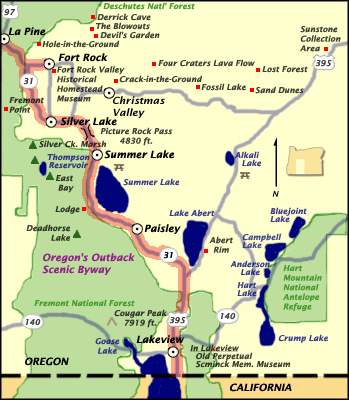
Length: 171 miles / 273.6 km
Time to Allow: Expect 3 to 4 hours to experience all this Byway has to offer.
Fees: There are no fees along the Byway proper.
Driving Directions
Take US Highway 97 south from Bend, Oregon. Just past La Pine is a junction with Oregon Highway 31 and the north end of the Byway. Travel south on Highway 31 toward Silver Lake and Lakeview. The Byway turns onto US 395 just north of Lakeview and continues south to the Oregon/California border.
Description
Learn for yourself why outback means "isolated rural country," when you drive through this rugged and remote area of Oregon. Let this Byway take you through Oregon's outback, where the agricultural and timber industries are tied to life, heritage, and values; where the landscape ranges from lush green forests to arid desert; and where the people that live here seek independence but know each other by first names. While you're here, you'll also notice that community is paramount to the people who call this area home.
Points of Interest
Abert Rim is the largest geological fault in North America. Abert Rim towers 2,500 feet above the valley floor in the Great Basin country of Eastern Oregon's high desert. Abert Lake, one of the world's few remaining inland seas, is at the northernmost base of the rim.
Fort Rock - About 27 miles east of U.S. Route 97, the forest abruptly gives way to vast sagebrush plains reminiscent of the Australian Outback. Like Australia's Ayer Rock, Oregon's Outback also has a mysterious rock formation that emerges from out of nowhere.
Fort Rock is the remains of a volcano that looks like a giant citadel rising 325 feet above the plain. Fort Rock was formed by super heated basalt magma roaring up through ground water as a boiling mud volcano, then cooling. It was formed some 5 to 6 million years ago. The ring of material left behind, called a maar, is the remains of this explosive event.
Fort Rock Homestead Village features a living history museum in the summer. The museum is a showcase of what life was like for early settlers. Also found here are stories of courageous men and women who fought the cruel natural elements such as: drought, unseasonable frost and jackrabbits.
Fossil Lake - Ten thousand years ago, flamingoes, camels, mammoths, and other post-Ice Age animals roamed the shores of a huge lake that covered the entire Fort Rock/Christmas Valley basin.
Fossil Lake is a dry 6,550-acre area that is a remnant of the much larger Pleistocene lake. Prehistoric fossils can be viewed on the surrounding. The fossils are considered rare because they are from small mammals not normally found in such volume and variety. The fossils are from 10,000 to 2 million years old. The bones, teeth and shells present are from mammoths, sloths, camels, flamingos, pelicans, salmon, snails, small birds and even chipmunks.
Today, Fossil Lake is recognized as one of the most significant sites in North America for Pleistocene age fossils. Many ancient animals were first discovered and named from specimens collected at Fossil Lake in the early 1900s. Although the area is fenced off and closed to OHV's, you are welcome to walk through the area and observe fossils. Please remember that federal law prohibits the collection of vertebrate fossils without a permit.